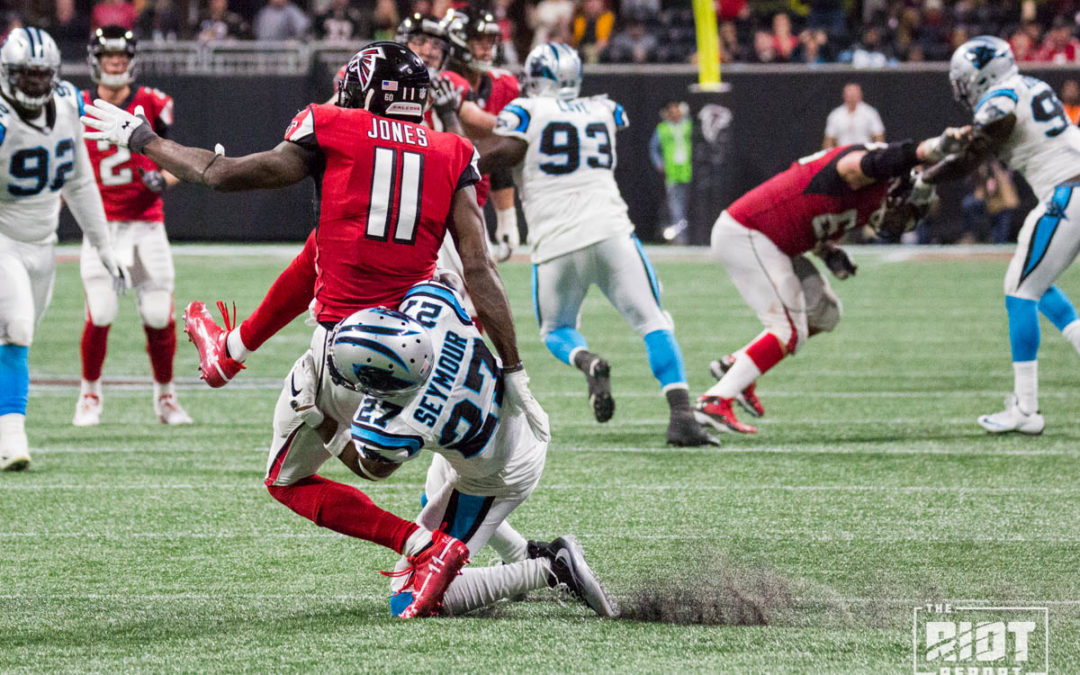There are very few certainties with regards to the 2018 Panthers’ secondary, with James Bradberry and Mike Adams likely the only players who the starter label can be assigned to with any degree of certainty – Captain Munnerlyn and Corn Elder are likely to continue to battle for the main nickel role into training camp, with Rashaan Gaulden and Da’Norris Searcy competing to see the majority of the snaps alongside Adams at safety. While Corn Elder has reportedly been taking snaps at outside corner as well and cannot be completely eliminated from the competition to start outside opposite Bradberry, the #2 corner will likely be one of Ross Cockrell, Donte Jackson or Kevon Seymour.
As a second round draft pick and free agent addition, Jackson and Cockrell have understandably attracted most of the attention, but so far in the offseason the majority of the starting snaps opposite Bradberry have gone to Seymour, the former sixth round draft pick who spent most of last season splitting snaps with Daryl Worley. Because of this, there isn’t a huge amount of tape on Seymour against NFL receivers, but from what he did show last season there is both a lot to like and some areas for concern.
Deep Speed
When you examine the moves the Panthers have made throughout the offseason, it is clear that an increase in defensive versatility was high on the priority list – Jackson, Gaulden and Cockrell all offer different matchup potentials, with a lot being made of Jackson’s deep speed and how that might help the Panthers who have to face both Ted Ginn and Desean Jackson twice a year. While Seymour can’t quite match Jackson’s 4.32 from the combine, his sub-4.4 forty time showed up on his 2017 tape. When tasked with covering receivers vertically, he showed both the quickness and the top end speed to prevent separation.
It also allows him to recover effectively when initially caught out of position. On the following play, he is initially caught looking in the backfield by the play action but his speed allows him to recover and take away the deep third assigned to him:
With the Panthers’ defensive scheme including more man coverage in recent seasons, the ability to match receivers for speed is becoming more important, and was part of the reason why Daryl Worley saw his playing time decrease last season as they moved away from the zone-heavy Sean McDermott defense; Seymour might not be the fastest player to ever step onto an NFL field, but he has adequate speed to cover man to man down the field.
Mirror and Match
Coverage is about a lot more than speed, with the ability to follow receivers through underneath routes relying on agility as much as speed. Seymour does show good lateral agility at low speeds, with the ability to flick his hips without having to open his body up completely, as seen on the following play:
At high speeds, he does show a reasonable transition on routes such as digs and comebacks, but here he shows a jerky motion which could lead to a loss of control:
This loss of control can be exposed by double moves, where his initial step out of his backpedal leads him off-balance and completely unable to recover when the receiver breaks back outside:
It is hard to tell whether the issue here is a physical or mental one. While the former is unlikely to improve, if the issue here is actually technique-based, then this could improve with time. It is also hard to judge just how much of an issue this might be until the Panthers progress to fully-padded practices in training camp, but there are some indicators on tape that he might be able to help himself; most notably through improved leverage.
On the following play, Seymour keeps his frame inside of the defender and so when the receiver breaks inside, Seymour is able to keep himself between the quarterback and the receiver.
By contrast, on the following play, he lines up well outside the receiver and without inside help he is left completely out of the play when the receiver breaks inside.
Additionally, as somebody who has the speed to run downfield with even faster receivers, he shouldn’t be giving significant cushions to receivers as this allows for extremely easy underneath completions, such as on the next play. It was understandable for the Panthers to use Worley in this way at times as he did struggle for vertical speed, but even if the Panthers are not going to have Seymour pressing right at the line of scrimmage, there is no advantage in having him this far up the field.
How much of this is coaching and how much is Seymour is impossible to say without inside knowledge of the Panthers’ scheme, but if Seymour is to be anything more than a stop-gap opposite Bradberry then he will need to show that he can consistently follow receivers through underneath routes as well as being able to run with them down the field. It isn’t clear from tape that this is something beyond his capability, but he will need to improve if he wishes to retain a starting spot over the likes of Cockrell and Jackson.



